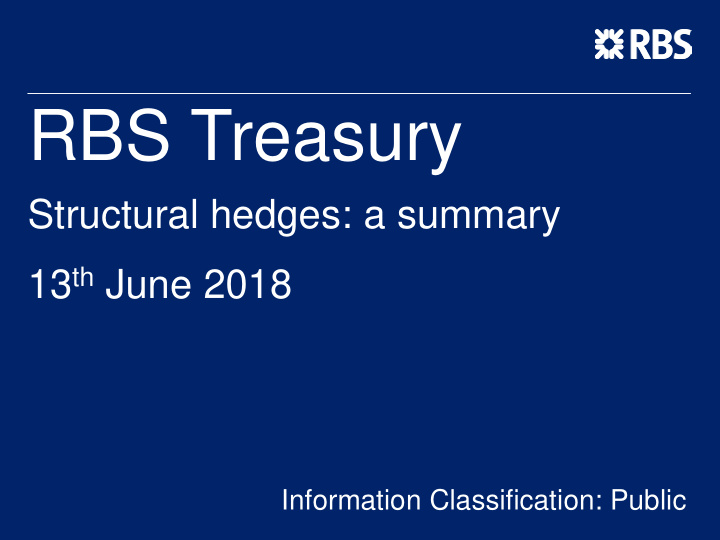



RBS Treasury Structural hedges: a summary 13 th June 2018 Information Classification: Public
Contents Comparison of rolling hedge rate and 3M LIBOR The components of the structural hedge Hedging mechanics Disclosure: structural hedge, earnings sensitivity and reserve sensitivity 2
Comparison of rolling hedge rate and 3M LIBOR The aim of structural hedging is to reduce the sensitivity of earnings to interest rate shocks. It also provides some protection against prolonged periods of falling rates. We assign an evenly amortising profile to the core element of some “indefinite maturity” liabilities. Equity, for example, is amortised monthly over a 10 year horizon. The balance is hedged on a matched basis. Each month only 1/120 th of the hedge matures and is reinvested. If the balance is stable, we eventually realise a yield equivalent to the 10 year average of the 10 year swap rate. The graph below shows how this provided protection to interest rate movements in recent years. 3m LIBOR, 10 year swap rates and 10 year rolling swap rate 10.00% 3 Month LIBOR Rolling 10y Rate 8.00% 6.00% 4.00% 2.00% 0.00% 01/10/2000 01/04/2001 01/10/2001 01/04/2002 01/10/2002 01/04/2003 01/10/2003 01/04/2004 01/10/2004 01/04/2005 01/10/2005 01/04/2006 01/10/2006 01/04/2007 01/10/2007 01/04/2008 01/10/2008 01/04/2009 01/10/2009 01/04/2010 01/10/2010 01/04/2011 01/10/2011 01/04/2012 01/10/2012 01/04/2013 01/10/2013 01/04/2014 01/10/2014 01/04/2015 01/10/2015 01/04/2016 01/10/2016 01/04/2017 01/10/2017 3
The components of the structural hedge Although ‘structural exposure’ can refer to various risks, the structural hedge is generally understood to refer to the net exposure to indefinite maturity liabilities: • primarily current accounts and also some deposit balances • equity and reserves also a significant element It is not easy to reconcile the hedged nominal directly to the spot balance sheet because we haircut the hedges for prudence and include miscellaneous less material balances (e.g. fixed assets, credit cards, goodwill). Additionally, subsidiary banks manage smaller structural exposures. They hedge against Treasury. Natural offsets to the exposure are primarily provided by five year fixes on residential mortgage loans plus other fixed rate assets. There are fixed rate assets that do not match the structural hedging benchmark of 5 to 10 years (i.e. two year residential mortgages) and which may be separately hedged. Overall we disclosed a nominal hedge of £149bn at December 2017. 4
Hedging mechanics The graphic shows how hedges might ‘gross up’ where the tenor of the mortgage fix does not match the structural hedge. Initially, the hedge requirements of the businesses are transferred to Treasury for execution. In this illustration a 2 year pay fixed swap, say, is needed to hedge mortgages, but a 5 year receive fixed swap is needed to hedge current accounts in line with our benchmark. Therefore Treasury execute hedges to the street against each exposure separately. The rate on execution is credited or charged back to the business. Hence the mortgage business receives a 2 year swap rate plus a spread from the customer and pays a 2 year swap rate to Treasury, The deposit business pays 0% (or a rate close to zero) on current accounts and receives a 5 year swap rate. 5
Disclosure 1: structural hedge We disclose detail on hedges managed directly by Treasury. This includes equity in Treasury’s books and current accounts and deposits in PBB and Commercial Banking. We show the income generated by the hedge in excess of 3M LIBOR, the average notional hedged over the period (in GBP equivalent) and the hedge yield. The yield is equivalent to the average fixed leg of the swap. Hedging may have be in the form of external swap execution or use of internal offsetting exposures, so the yield is a proxy derived from income that was allocated to the products based on swap rates at the time the hedging requirement arose. All Treasury income from structural hedging is allocated to franchises. At year end 2017 we also provided an indication of the contribution from smaller customer hedges in Private Banking, RBS International, UBIDAC and Ulster Bank Limited: 6
Disclosure 2: earnings sensitivity We disclose the sensitivity to a instant parallel shift upwards of 25bps across all yield curves assuming a constant balance sheet. At December 2017 the benefit to interest income was estimated at £178m over 12 months, compared to a scenario where the yield curve followed market expectations. We also indicate how much benefit would be realised through hedging at higher rates, compared to the benefit expected to accrue from wider margins on unhedged deposits. Years 2 and 3 provide an indication of how the benefit of higher rates to interest income will evolve over time. While the annual interest income benefit to unhedged deposits is realised in year 1 and, more or less, repeated in outer years, the main benefit to the structural hedge arises in years 2 and 3 as more hedges are replaced with new hedges at higher rates. 7
Disclosure 3: reserve sensitivity We also disclose the sensitivity of reserves to up and down instantaneous parallel shifts in interest rates. The main item to note is that most interest rate swaps relating to structural hedging are accounted for as cash flow hedges. The swaps are the primary driver of cash flow hedge reserve sensitivity. The table shows the adverse sensitivity is to higher rates. The impact on swap valuations is recognised instantly. However, as the swap cash flows are realised and accrued as interest income in P&L the negative impact on the reserve will unwind. 8
Recommend
More recommend